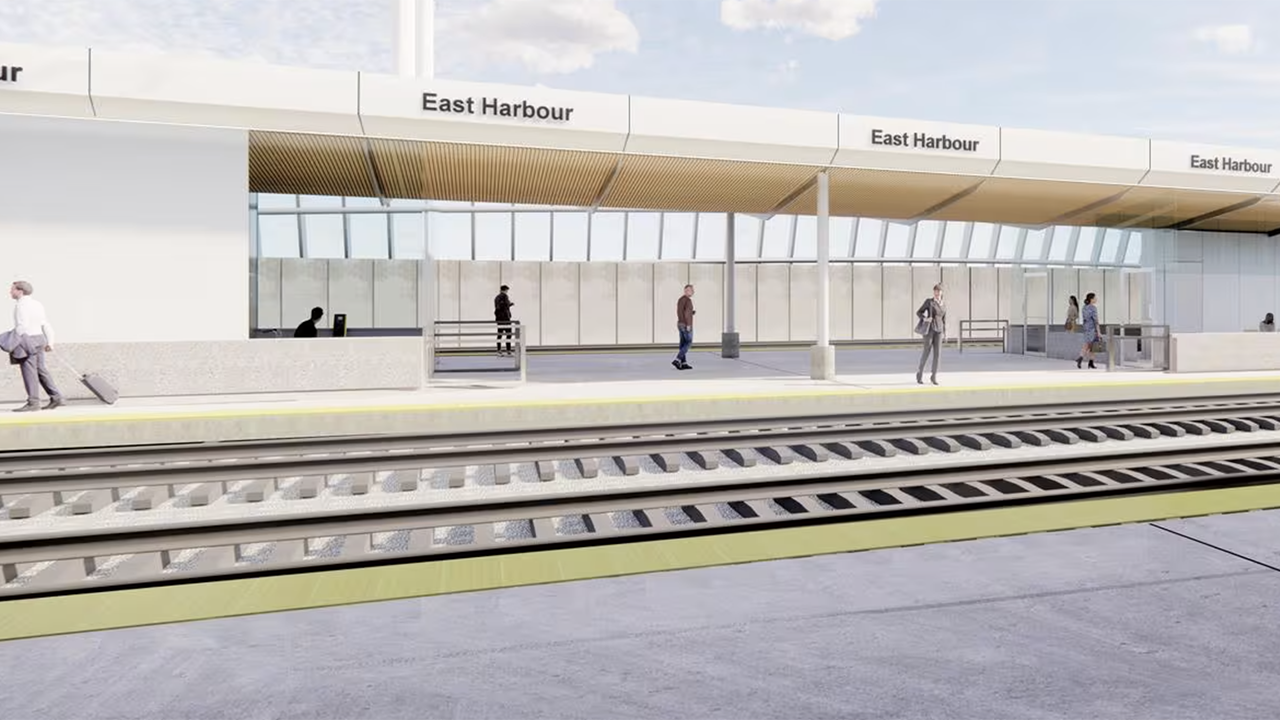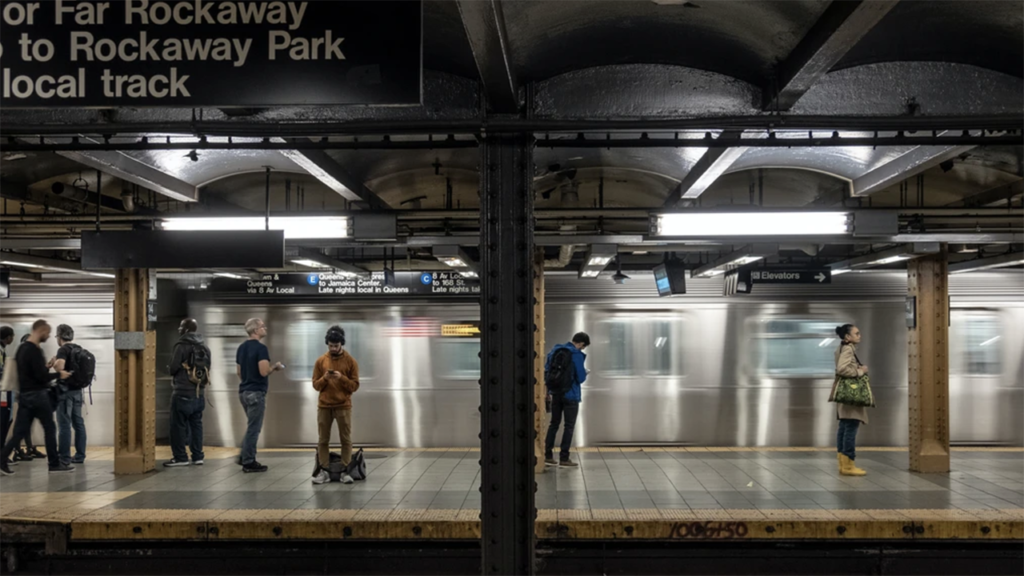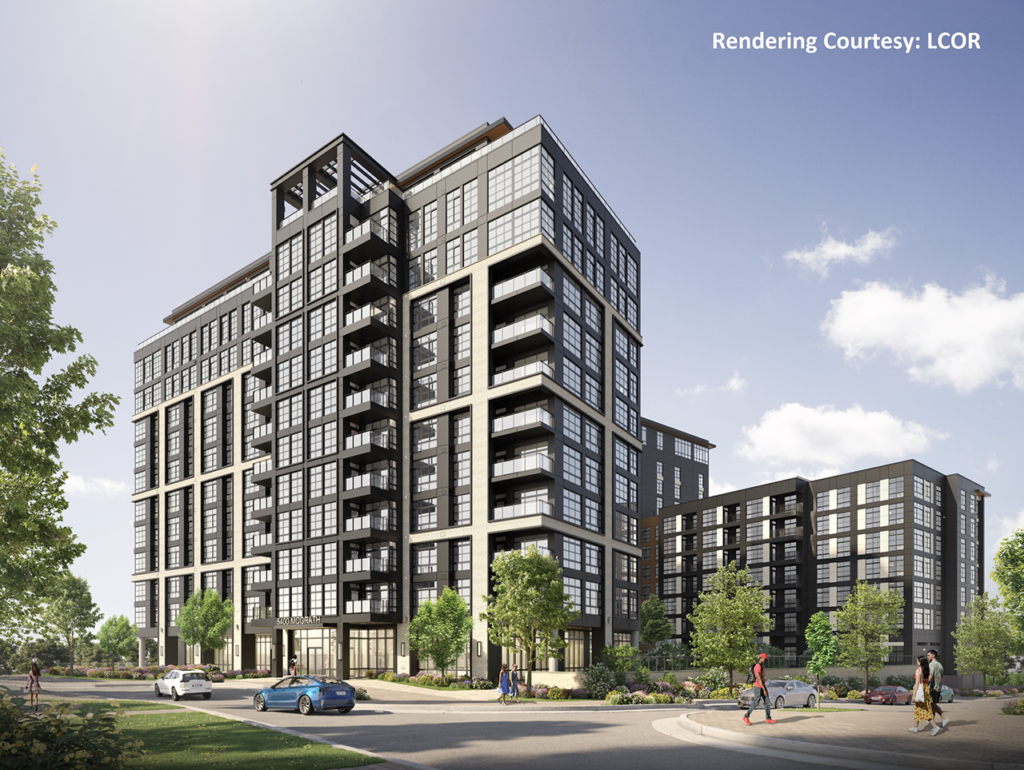
Transit Briefs: Metrolinx, Transit Tech Lab, WMATA
Written by Marybeth Luczak, Executive Editor
Metrolinx’s East Harbour Transit Hub in Toronto will be located on the Lakeshore East and Stouffville GO Transit rail lines. The station will provide connections to the Ontario Line subway and future Toronto Transit Commission services. (Rendering Courtesy of Metrolinx)
The Rail Connect Partners joint venture has entered into an alliance development agreement with Toronto’s Metrolinx for the East Harbour Transit Hub. Also, New York regional transportation agencies launch their sixth-annual tech competition; and Washington Metropolitan Area Transit Authority (WMATA) celebrates a transit-oriented development project at the North Bethesda Metro Station in Maryland.
Metrolinx
Rail Connect Partners, the 50/50 joint venture of AtkinsRéalis and Bird Construction Inc., has entered into an alliance development agreement with Metrolinx to work on project management and construction of the East Harbour Transit Hub in Toronto.
According to Metrolinx, the East Harbour Transit Hub will be an interchange station in the Riverdale neighborhood, immediately east of the Don Valley Parkway and south of Eastern Avenue. Located on the Lakeshore East and Stouffville GO commuter rail lines, the station will provide connections to the Ontario Line subway and future Toronto Transit Commission services.
The East Harbour Transit Hub project includes a concourse area with customer amenities and accessible drop off; connections to the future Broadview Ave extension; GO platforms for local and express train service, including elevators; a multi-use path and trail bridge and landings over the Don River; and Eastern Avenue Bridge reconstruction to support both GO transit and the new Ontario Line subway. It will allow for a single-train connection to Pickering, Whitby, and Oshawa, as well as destinations such as Mississauga, Oakville, and Hamilton.
Based on preliminary analysis, the East Harbour Transit Hub is expected to bring about 100,000 daily riders, according to Metrolinx.
The East Harbour Transit Hub, part of Toronto’s SmartTrack Stations Program, is said to be one of the first major projects in Canada to be procured using an “alliance” model. “The alliance model has been used internationally to plan and deliver large, complex infrastructure programs, driving innovation and collaboration between parties,” according to Bird Construction Inc. “The alliance model is better equipped to manage risk with greater transparency and cooperative decision-making.”
Under the alliance development agreement, Rail Connect Partners will optimize project design; prepare detailed estimates for resources, costs and schedules; prepare a project proposal; finalize the project alliance agreement; and perform early works.
“The alliance development agreement represents a significant development for us in how we execute large projects without a fixed-price contract model; we are thrilled to work closely with our alliance partners to apply this collaborative model to deliver an exciting new regional transportation hub,” AtkinsRéalis President and CEO Ian L. Edwards said. “We are proud to contribute to improving transportation links in the Greater Toronto Area and developing innovative solutions to improve accessibility for commuters.”
“This significant award advances our strategic priority to grow our infrastructure portfolio while maintaining our disciplined pursuit of projects with appropriate risk profiles,” said Teri McKibbon, President and CEO of Bird Construction Inc. “We are proud to play a key role in this project where we can leverage Bird’s extensive collaborative contracting experience along with our comprehensive self-perform capabilities including the specialized services of Dagmar, acquired in 2021.”
Transit Tech Lab

Applications are open for the 2024 Transit Tech Lab competition, led by New York Metropolitan Transportation Authority (MTA), Port Authority of New York and New Jersey (PANY/NJ), New Jersey Transit (NJT), New York City Department of Transportation (NYC DOT), and Partnership for New York City. Applications are due Feb. 28, 2024, for the three challenges: Customer Experience, Resilience, and Curb Activity.
Representatives from each participating transit agency will evaluate applications based on “the technology’s impact and the applicant’s product, team, and overall value proposition,” according to Transit Tech Lab, co-founded by MTA and the Partnership Fund for New York City. Finalists will advance to conduct a proof-of-concept over an eight-week period. “The companies demonstrating the most compelling technologies that align with the agencies’ objectives” will have the opportunity to secure a yearlong pilot,” Transit Tech Lab reported.
The Customer Experience challenge covers how the customer experience can be improved by better communicating service changes, reducing delays, and augmenting safety and cleanliness initiatives. Technologies may include:
- Tools, including gamification, to encourage paid ridership.
- Improved methods for customer-facing communication to convey schedule diversions, delays, alternative transit options, and onboard train announcements.
- Tools to improve processing of customer feedback, including processes to manage internal response and more timely communications back to customers.
- Predictive analytical tools to estimate average outage time for common delays.
- Tools to detect, prioritize, and maintain safety and cleanliness in stations and vehicles.
- Improved tools to facilitate paratransit operations, including improving the processing and evaluation of paper-based eligibility requests and improving communication of issues relevant to paratransit customers.
- Tools to help commuter railroads understand passenger flows and predict customer travel patterns flows to better optimize schedules.
- Tools to optimize right-of-way work via improving planning, coordinating outages, managing equipment, and prioritizing flagging resources.
- Augmented reality/virtual reality technologies to digitize safety, operations, maintenance and construction training.
The Resilience challenge covers how to build a more resilient and adaptive transit system. Technologies may include:
- Technologies to predict which transit assets across the system may be at risk from extreme weather and other climate change-related events.
- Tools to help mitigate climate-related vulnerabilities across the system.
- Tools to enhance stormwater resilience, including tools to prevent water intrusion and to expedite water removal.
- Technologies to augment manual surveying and inspection work on aging infrastructure (especially right of way and retaining walls).
- Electrification tools to enable more dynamic charging and EV fleet management.
- Tools to optimize battery-electric bus charging operations.
- Tools to power resiliency at bus depots, including the use of microgrids and renewable battery charging.
- “Green” construction materials.
The NYC DOT’s Curb Activity challenge covers how to maximize New York City’s curb space. Technologies may include:
- Tools to support efficient and orderly use of curb space for non-car uses, such as cargo bikes, micromobility devices.
- Tools to enable use of curb space for recreation or commerce.
- Tools that support using curb space to improve pedestrian safety, such as new ways to protect daylighted intersections).
- Tools to prevent unauthorized use of curb space (e.g., retractable bollards).
- Tools to more effectively communicate allowable curb uses (new markings or signage types, but which take into account maintenance issues).
- Tools to monitor curb usage of various vehicle types, such as trucks, buses and bikes.
The aim of the Curb Activity challenge is to help NYC DOT implement the Curb Management Action Plan and enable better decision-making and regulations. NYC DOT is calling for “scalable technology” to provide data that will help it better understand curb inventory: what regulations, restrictions and features are where, and/or who is using the curb in what way.
“The Transit Tech Lab continues to be a significant incubator of innovative solutions for the most pressing transportation challenges the MTA and other regional transportation agencies face,” said Jessica Mathew, Senior Advisor for Special Projects at MTA. “We look forward to seeing the next set of proposed technologies that will strengthen the MTA’s ongoing resiliency efforts and further the Authority’s mission to improve the customer experience for transit riders.”
“We’ve seen transportation technology and innovation developing at a breakneck pace in recent years, and it’s critical that we learn how to harness these advancements as a public agency, for the public good,” PANY/NJ Chief Technology Officer Rob Galvin said. “The Transit Tech Lab has been an ideal partner for that effort, connecting us with companies that open a new world of possibilities as we look to enhance our operations, customer service, and environmental sustainability efforts across our diverse portfolio of properties.”
Since 2018, Transit Tech Lab has fielded more than 750 applicants, tested 51 technologies, and facilitated eight commercial engagements.
Further Reading:
NYMTA Transit Tech Lab Releases POC Results of Operational Efficiency and Human Capital Challenges
NYMTA Transit Tech Lab Announces Recovery and Sustainability Challenge Winners
NYMTA Transit Tech Lab Reports Signaling Challenge Proof-of-Concept Results
WMATA

WMATA on Jan. 8 held a groundbreaking ceremony for a new 12-floor, 354-unit residential building being constructed by LCOR at the North Bethesda Metro Station (see rendering above). It will be located on a 1.6-acre parcel owned by WMATA and ground leased to LCOR, through the transit authority’s Joint Development Program.
The building is the final phase of a 2001 joint development agreement between WMATA and LCOR and is the fourth residential building constructed at the site as part of the “The Quad at [North Bethesda] Pike District,” WMATA said. Once completed, the WMATA-LCOR partnership will result in 2 million square feet of mixed-use development at the station, including 1,300 residential units, of which 164 will be affordable housing.
WMATA reported receiving more than $40 million in upfront ground lease payments, fees, and other payments from the development, which is slated to generate approximately $350 million in state and local tax revenues over the next 30 years.
The project is also supported by the More Housing at Metro Act, enacted by Montgomery County in 2021, “to incentivize development of transit-accessible, affordable housing units” on WMATA properties in Montgomery County, according to the transit authority.
“This project at North Bethesda shows the positive impacts of Metro’s [WMATA] partnerships across the region, generating economic benefit, creating new revenue and ridership for Metro, and supporting sustainability through transit-oriented development,” WMATA General Manager and CEO Randy Clarke said. “We have the most robust joint development program in the nation and plan to accelerate development of Metro’s assets in the District, Maryland, and Virginia to help maintain safe, reliable, and affordable transportation.”
WMATA said it has an additional 13 acres of undeveloped property at the North Bethesda Station and is working with the county on an initiative “to create a life science anchored transit-oriented development.”
Since 1975, WMATA has completed 55 joint development projects totaling 17 million square feet at 30 of its 98 stations.
Under its 10-Year Strategic Plan for Joint Development, WMATA said it seeks to advance 20 joint development projects by 2032. Current mixed-use projects are under construction at College Park-U of MD, Grosvenor-Strathmore, and New Carrollton stations. Predevelopment efforts are under way for projects at Capitol Heights, Congress Heights, Brookland-CUA, Fort Totten, Deanwood, Forest Glen, Takoma, Lottsford Road, West Hyattsville, Landover, Mill Road, Huntington, and West Falls Church.



